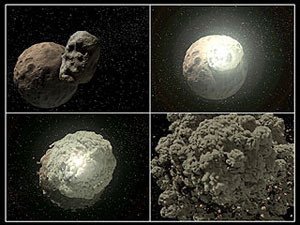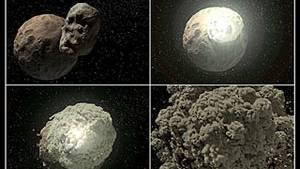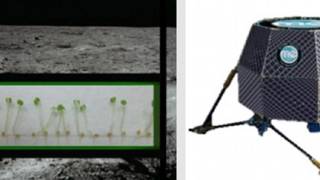Earth's Moon a rare species
Source: cosmosmagazine.com
 Cosmic collisions: Artist's impression of bodies as big as mountain ranges smashing together. Such collisions form the basis of the planet-building process. An even bigger collision between Earth and a body the size of Mars is thought to have created our moon. Image: NASA/JPL/Caltech |
Billions of years ago, an object the size of Mars crashed into the Earth, hurling dust and debris into orbit. Some of this material eventually coalesced to form our Moon.
Now a new study in The Astrophysical Journal reports that only five to 10 per cent of planetary systems in the universe have moons created this way.
"When a moon forms from a violent collision, dust should be blasted everywhere," said lead author Nadya Gorlova of the University of Florida, Gainesville. "If there were lots of moons forming, we would have seen dust around lots of stars - but we didn't."
A trail of dust
Using NASA's Spitzer Space Telescope, Gorlova and colleagues looked for the dusty signs of similar collisions. They examined 400 stars that are all about 30 million years old - roughly the age of our Sun when Earth's moon formed.
They found only one out of the 400 stars immersed in the telltale dust. Taking into account the amount of time the dust should stick around, and the age range at which moon-forming collisions can occur, the researchers calculated the probability of a solar system making a moon like Earth's to be at most five to 10 per cent.
Rocky planet window
Like our moon, rocky planets are built up through messy collisions that scatter dust and debris around. Current thinking holds that this process lasts from about 10 to 50 million years after a star forms.
But the fact that Gorlova and her team found only one star out of 400 with collision-generated dust, suggests that the 30-million-year-old stars in the study have, for the most part, finished making their planets.
"We don't know that the collision we witnessed around the one star is definitely going to produce a moon, so moon-forming events could be much less frequent than our calculation suggests," said George Rieke of the University of Arizona, Tucson, a co-author of the study.
But for moon lovers, the news isn't all bad. For one thing, moons can form in different ways: the other moons in our solar system either formed simultaneously with their planet or were captured by their planet's gravity.
And even though the majority of rocky planets in the universe might not have moons like Earth's, there are billions of rocky planets out there, so five to 10 percent is a lot of moons.
Article from: http://www.cosmosmagazine.com/node/1720






















